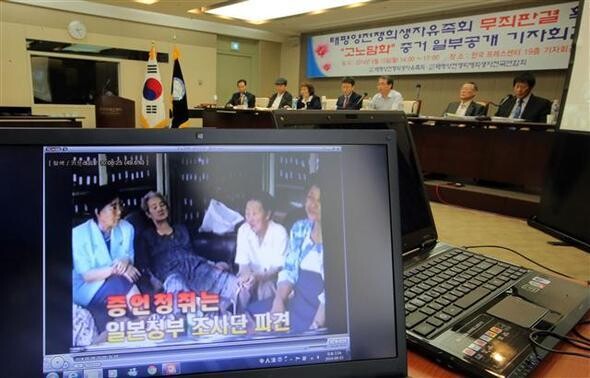hankyoreh
Links to other country sites 다른 나라 사이트 링크
Comfort women video testimony made public after 21 years

By Song Ho-kyun, staff reporter
With the Japanese government taking steps to subvert the Kono Statement, which acknowledged that women had been forced to serve as sex slaves for the Japanese imperial army, the Association for the Pacific War Victims made public a video recording showing Japanese government investigators receiving testimony from former comfort women about 20 years ago. Since this material served as the grounds for the Kono Statement, the group had agreed to a request from the Japanese government not to publish it.
The association met with reporters at the Seoul Press Center on Sept. 15 and released a 15-minute video showing Japanese government investigators listening to the testimony of 16 former comfort women. The video was recorded 21 years ago, at the end of July 1993, just before the release of the Kono Statement. The video is one segment of a recording of the testimony. The comfort women provided the testimony at the association’s office, which was located in the Yongsan District of Seoul at the time.
The released video contains scenes of the former comfort women telling the Japanese government investigators through interpreters about the brutality they had suffered and arranging the schedule for their testimony.
“When I was 18 years old, I spent two or three weeks in an attic after my uncle told me that young women were being taken away. After that I came down from the attic to find something to eat when all of a sudden a Japanese policeman appeared in front of me, grabbed me by the arm, and dragged me off,” said Kim Bok-seon in the recording. Kim, a former comfort woman, died on Dec. 12 at the age of 86.
“I was weeping with fear, clinging to the pillar in the room. I tried to run away, but in the end they took me to Busan. I became a comfort woman for the Japanese imperial army, and was moved to Simonoseki and then Osaka,” said Yoon Sun-man, 83.
“I got beat a lot for being disobedient. My arms were twisted and still are today,” Yun said, lifting her weak knees and her left elbow, which is still crooked though decades have passed.
While it was not included in the video released on Monday, the association also made public the written testimony of Kil Gap-soon, who also took part in the Japanese investigation.
“When I refused to sleep with the Japanese soldiers, they tortured me by searing my back with a red-hot soldering iron,” Kil said. She raised her blouse and showed the Japanese investigators the burn marks that still remained on her back. Gil passed away in 1998 at the age of 74, five years after giving her testimony.
“Aside from Yoon Sun-man and Kim Kyung-sun, the other 14 of the 16 women who testified at the time have already died. Now the Abe government is showing its blatant intention to attack the Kono Statement,” said Kim Young-man, 58, Gil’s son.
“We refrained from publishing the material for 21 years at the request of the Japanese government. But now that the Abe government is distorting the truth of the Kono Statement, we decided to publish part of the recording. In the future, we will prepare a white paper about the Kono Statement and submit it to the UN for the consideration of the entire world,” said Yang Soon-im, president of the association who was present during the testimony.
Please direct questions or comments to [english@hani.co.kr]

Editorial・opinion
![[Editorial] Does Yoon think the Korean public is wrong? [Editorial] Does Yoon think the Korean public is wrong?](https://flexible.img.hani.co.kr/flexible/normal/500/300/imgdb/original/2024/0417/8517133419684774.jpg) [Editorial] Does Yoon think the Korean public is wrong?
[Editorial] Does Yoon think the Korean public is wrong?![[Editorial] As it bolsters its alliance with US, Japan must be accountable for past [Editorial] As it bolsters its alliance with US, Japan must be accountable for past](https://flexible.img.hani.co.kr/flexible/normal/500/300/imgdb/original/2024/0417/6817133413968321.jpg) [Editorial] As it bolsters its alliance with US, Japan must be accountable for past
[Editorial] As it bolsters its alliance with US, Japan must be accountable for past- [Guest essay] Amending the Constitution is Yoon’s key to leaving office in public’s good graces
- [Editorial] 10 years on, lessons of Sewol tragedy must never be forgotten
- [Column] A death blow to Korea’s prosecutor politics
- [Correspondent’s column] The US and the end of Japanese pacifism
- [Guest essay] How Korea turned its trainee doctors into monsters
- [Guest essay] As someone who helped forge Seoul-Moscow ties, their status today troubles me
- [Editorial] Koreans sent a loud and clear message to Yoon
- [Column] In Korea’s midterm elections, it’s time for accountability
Most viewed articles
- 1[Column] The clock is ticking for Korea’s first lady
- 2[News analysis] After elections, prosecutorial reform will likely make legislative agenda
- 3Samsung barricades office as unionized workers strike for better conditions
- 4S. Korea, Japan reaffirm commitment to strengthening trilateral ties with US
- 5[Editorial] When the choice is kids or career, Korea will never overcome birth rate woes
- 6[Editorial] Does Yoon think the Korean public is wrong?
- 7Why Israel isn’t hitting Iran with immediate retaliation
- 8Japan officially says compensation of Korean forced laborers isn’t its responsibility
- 9[Editorial] As it bolsters its alliance with US, Japan must be accountable for past
- 10Strong dollar isn’t all that’s pushing won exchange rate into to 1,400 range